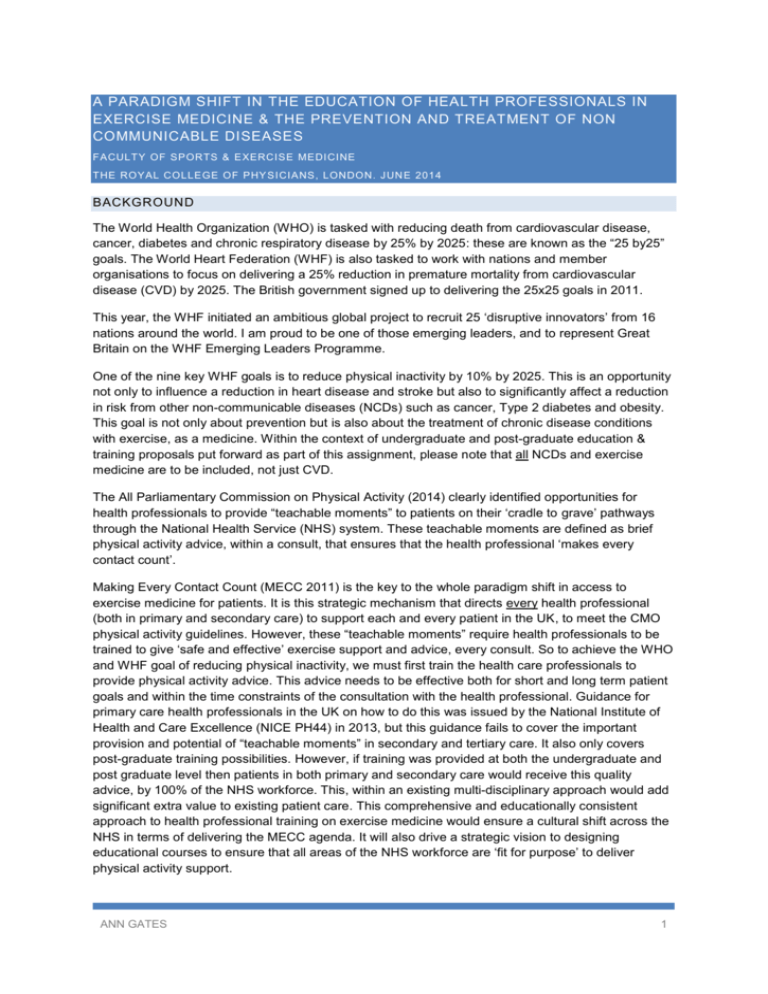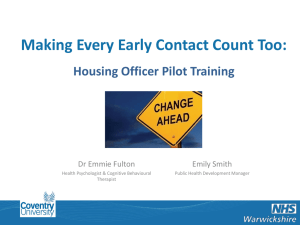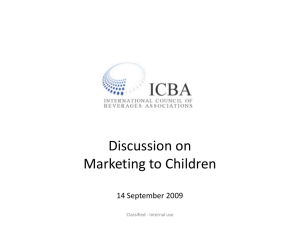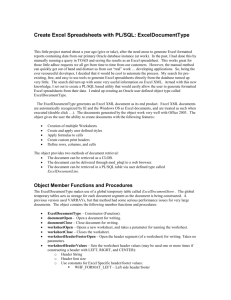here - Exercise Works!
advertisement

A PARADIGM SHIFT IN THE EDUCATION OF HEALTH PROFESSIONALS IN EXERCISE MEDICINE & THE PREVENTION AND TREATMENT OF NON COMMUNICABLE DISEASES FACULTY OF SPORTS & EXERCISE MEDICINE THE ROYAL COLLEGE OF PHY SICIANS, LONDON. JUN E 2014 BACKGROUND The World Health Organization (WHO) is tasked with reducing death from cardiovascular disease, cancer, diabetes and chronic respiratory disease by 25% by 2025: these are known as the “25 by25” goals. The World Heart Federation (WHF) is also tasked to work with nations and member organisations to focus on delivering a 25% reduction in premature mortality from cardiovascular disease (CVD) by 2025. The British government signed up to delivering the 25x25 goals in 2011. This year, the WHF initiated an ambitious global project to recruit 25 ‘disruptive innovators’ from 16 nations around the world. I am proud to be one of those emerging leaders, and to represent Great Britain on the WHF Emerging Leaders Programme. One of the nine key WHF goals is to reduce physical inactivity by 10% by 2025. This is an opportunity not only to influence a reduction in heart disease and stroke but also to significantly affect a reduction in risk from other non-communicable diseases (NCDs) such as cancer, Type 2 diabetes and obesity. This goal is not only about prevention but is also about the treatment of chronic disease conditions with exercise, as a medicine. Within the context of undergraduate and post-graduate education & training proposals put forward as part of this assignment, please note that all NCDs and exercise medicine are to be included, not just CVD. The All Parliamentary Commission on Physical Activity (2014) clearly identified opportunities for health professionals to provide “teachable moments” to patients on their ‘cradle to grave’ pathways through the National Health Service (NHS) system. These teachable moments are defined as brief physical activity advice, within a consult, that ensures that the health professional ‘makes every contact count’. Making Every Contact Count (MECC 2011) is the key to the whole paradigm shift in access to exercise medicine for patients. It is this strategic mechanism that directs every health professional (both in primary and secondary care) to support each and every patient in the UK, to meet the CMO physical activity guidelines. However, these “teachable moments” require health professionals to be trained to give ‘safe and effective’ exercise support and advice, every consult. So to achieve the WHO and WHF goal of reducing physical inactivity, we must first train the health care professionals to provide physical activity advice. This advice needs to be effective both for short and long term patient goals and within the time constraints of the consultation with the health professional. Guidance for primary care health professionals in the UK on how to do this was issued by the National Institute of Health and Care Excellence (NICE PH44) in 2013, but this guidance fails to cover the important provision and potential of “teachable moments” in secondary and tertiary care. It also only covers post-graduate training possibilities. However, if training was provided at both the undergraduate and post graduate level then patients in both primary and secondary care would receive this quality advice, by 100% of the NHS workforce. This, within an existing multi-disciplinary approach would add significant extra value to existing patient care. This comprehensive and educationally consistent approach to health professional training on exercise medicine would ensure a cultural shift across the NHS in terms of delivering the MECC agenda. It will also drive a strategic vision to designing educational courses to ensure that all areas of the NHS workforce are ‘fit for purpose’ to deliver physical activity support. ANN GATES 1 ASSIGNMENT AIMS There are 3 strategic aims of this assignment. To: 1. identify, develop and deliver training to all allied health professionals and outreach workers to provide effective physical activity advice and support to every patient, every consult. 2. identify, develop and deliver training to all surgeons and their MDT’s, in all fields, to provide effective physical activity advice and support to every pre- and post-operative patient, every consult. 3. identify, develop and deliver training to all physicians and general practitioners to provide effective physical activity advice and support to every patient, every consult. These aims incorporate and underpin all aspects of undergraduate, postgraduate, and continuous medical education (CME) and professional development training required to deliver the MECC & the physical activity agenda. They also provides a unique opportunity for all health professionals to fully understand the complexities of how health, disease, lifestyle choices and genes interact during their training and practice. GLOBAL VISION AND AMBITION To achieve this for Great Britain would be remarkable but here is an opportunity for the medical and health bodies in Great Britain to lead the world on providing a detailed strategic plan on delivering the project aims. The global networks offered by the WHF together with the Royal Colleges network of professionals could create a ‘tipping point’ moment in the way in which we teach and practice exercise medicine. This would indeed establish MECC as a conduit for successful physical activity interventions and promote Great Britain on leading the way on NCD management with exercise medicine. DISCUSSION AND RECOM MENDATIONS The strategic detail required to ensure these strategic aims are met, is fully recognised. No one person or medical body has been able to strategically influence the training of health professionals in this way before. I know this is a huge undertaking for the Faculty and Royal Colleges- but no one ever said that achieving a cultural and seismic shift in medicine was easy! We are all aware of the extensive evidence supporting exercise as a medicine. We are all aware of the need to train our undergraduates. However, what this proposal adds in value is a comprehensive, “no gaps” approach to strategic delivery at the patient level. To focus on just undergraduate training in exercise medicine loses the potential to provide complete coverage for “teachable moments,” every contact. To include post graduate courses and training to all health professionals offers both the Faculty and other health bodies the opportunities to enrich qualified professional’s knowledge, practice and successful consults in a way that embodies the purpose of MECC. From a patients perspective it guarantees, that whatever disease, whichever health professional they interact with, they can rely on receiving quality exercise advice, support, signposting and improved health outcomes. OPTION APPRAISAL Four potential strategic options are available and are summarised in Table 1. SUMMARY The WHF Emerging Leaders Programme, has provided the catalyst for a paradigm shift in the way we train NHS health professionals to be ‘fit for purpose’ to deliver on the physical inactivity agenda and the 25x25 goals. A comprehensive strategy to train health professionals in exercise medicine, is now urgent, crucial, and would provide the framework to make every contact count, for physical activity. ANN GATES 2 BIBLIOGRAPHY & CONTEXT World Health Organization (WHO) 2011 Political Declaration on Noncommunicable Diseases (NCDs) adopted by the UN General Assembly in 2011. WHO developed a global monitoring framework to enable global tracking of progress in preventing and controlling major non-communicable diseases - cardiovascular disease, cancer, chronic lung diseases and diabetes - and their key risk factors: http://www.who.int/nmh/global_monitoring_framework/en/ World Heart Federation 2014 media brief for the 25x25 goals: http://www.worldheart-federation.org/fileadmin/user_upload/Congress/WCC2014/BACKGROUNDER25x25_-FINAL.pdf World Heart Federation Champion Advocate Programme 2013 http://www.championadvocates.org/en World Heart Federation Emerging Leaders Programme 2014 http://www.championadvocates.org/en/emerging-leaders Overview by The Lancet 2014, by Robert Beaglehole, Ruth Bonita and Richard Horton on the UK sign up to delivering the 25x25 goals: http://nhfshare.heartforum.org.uk/RMAssets/LancetSeries4/Document5.pdf All Parliamentary Commission on Physical Activity 2014 http://parliamentarycommissiononphysicalactivity.files.wordpress.com/2014/04/apco pa-final.pdf Making Every Contact Count (MECC) 2011 http://www.healthyambitions.co.uk/Uploads/BetterForLess/08%20BETTER%20FOR %20LESS%20every%20contact%20counts.pdf Chief Medical Officers 2011 UK Physical Activity Guidelines https://www.gov.uk/government/publications/uk-physical-activity-guidelines National Institute of Health and Care Excellence (NICE) 2013: Physical activity: brief advice for adults in primary care (PH44) http://www.nice.org.uk/PH44 Tipping point definition: http://en.wikipedia.org/wiki/Tipping_point_(sociology) For more information on the effect of physical inactivity on major non-communicable diseases worldwide: an analysis of burden of disease and life expectancy please see the Lancet Physical Activity Series Working Group, I-Min et al: http://www.thelancet.com/series/physical-activity ANN GATES 3







